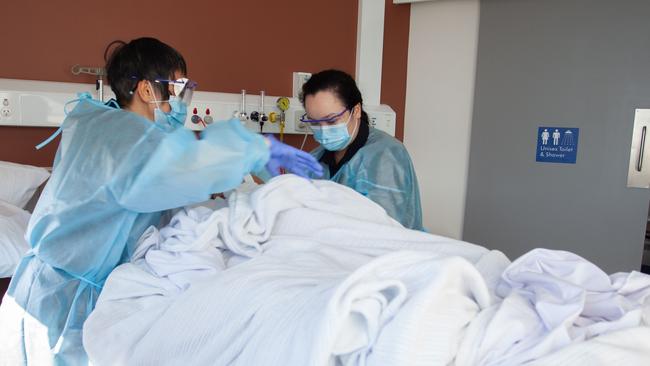Coronavirus: Deficient practices blamed for surge
Poor practices have been blamed for a dramatic surge in the proportion of Victoria’s health sector employees acquiring the illness at work.

Poor infection control, staff interacting on tea breaks and the practice of grouping coronavirus-infected patients in the same room have been blamed for a dramatic surge in the proportion of Victoria’s health sector employees acquiring the illness at work.
More than 69 per cent of healthcare workers diagnosed with COVID-19 in July and August were infected in the workplace, compared with 22 per cent during the first wave of the pandemic, a new report has revealed.
On average, about 34 health workers have been diagnosed every day throughout August, with aged and disability carers the hardest hit.
Detailed analysis of infections, released by the Victorian Department of Health and Human Services on Tuesday, has forced the government to unveil a raft of measures to stem the spread in healthcare settings.
Among them is an expansion of guidance on N95 respirators, which would increase their usage significantly from 50,000 to 800,000 a week as they are made available in emergency departments, intensive care units, COVID-19 wards and aged-care homes.
All health services will face checks to ensure they comply with COVIDSafe measures, PPE “spotters” will be deployed to ensure accurate application and removal of protective wear and extra support will be rolled out to aged-care settings in a bid to improve infection control.
In addition, health services will be required to self-assess their amenities to ensure they meet minimum standards for physical distancing, cleanliness and infection control.
The new measures will be implemented on the advice of a newly established Healthcare Worker Infection Prevention and Wellbeing Taskforce.
They come after a review of COVID-19 cases among healthcare workers identified emerging risk factors for acquisition and secondary transmission in hospital settings, including multiple coronavirus-positive patients being in the same clinical space.
“This has clear implications for the cohorting … and care of patients with the virus,” it said.
“In addition, healthcare workers are contracting coronavirus when putting on PPE, and when interacting with other health workers outside of patient care (for example, in tea rooms when PPE is not worn) and movement between facilities.”
UNSW biosecurity expert Raina MacIntyre said the data was a wake-up call but the measures did not go far enough. “Self-assessment of hospitals is not adequate,” she said.
“Hospitals already report on criteria such as wound infections and a range of patient outcome measures for external accreditation. Work health and safety standards should also be subject to external review and audit.”
Professor MacIntyre questioned putting blame with health workers, particularly singling out staff mingling in tea rooms while not wearing PPE. “This is … not based on scientific evidence, and is a distraction from the requirement to adequately protect health workers,” she said.



To join the conversation, please log in. Don't have an account? Register
Join the conversation, you are commenting as Logout